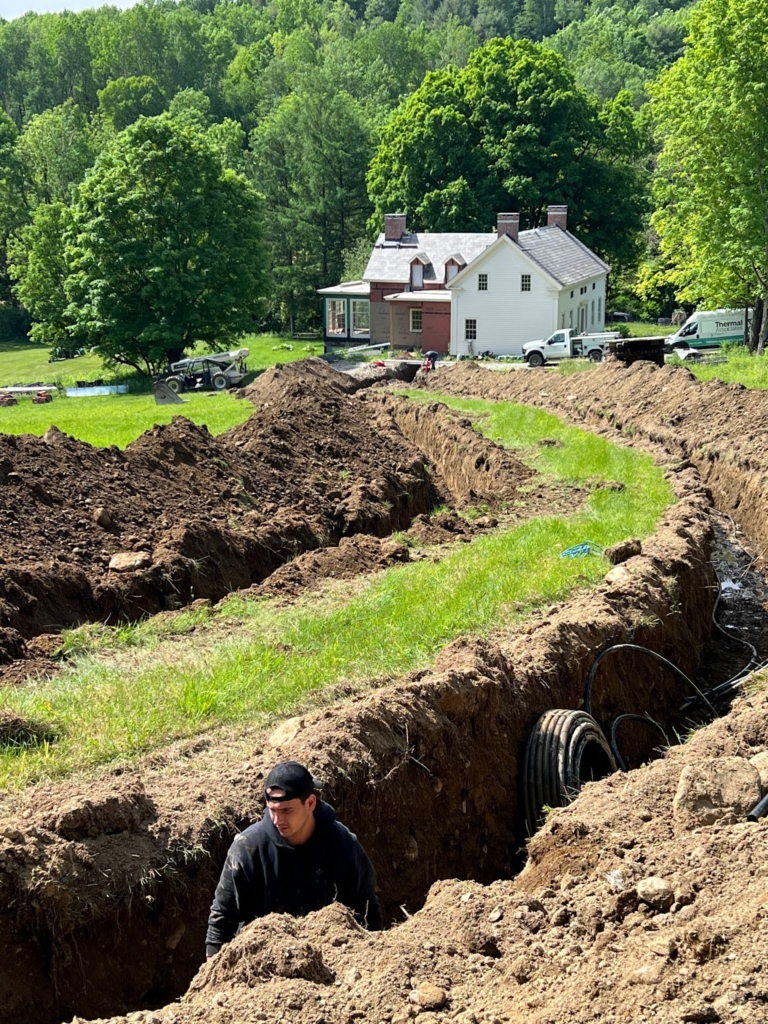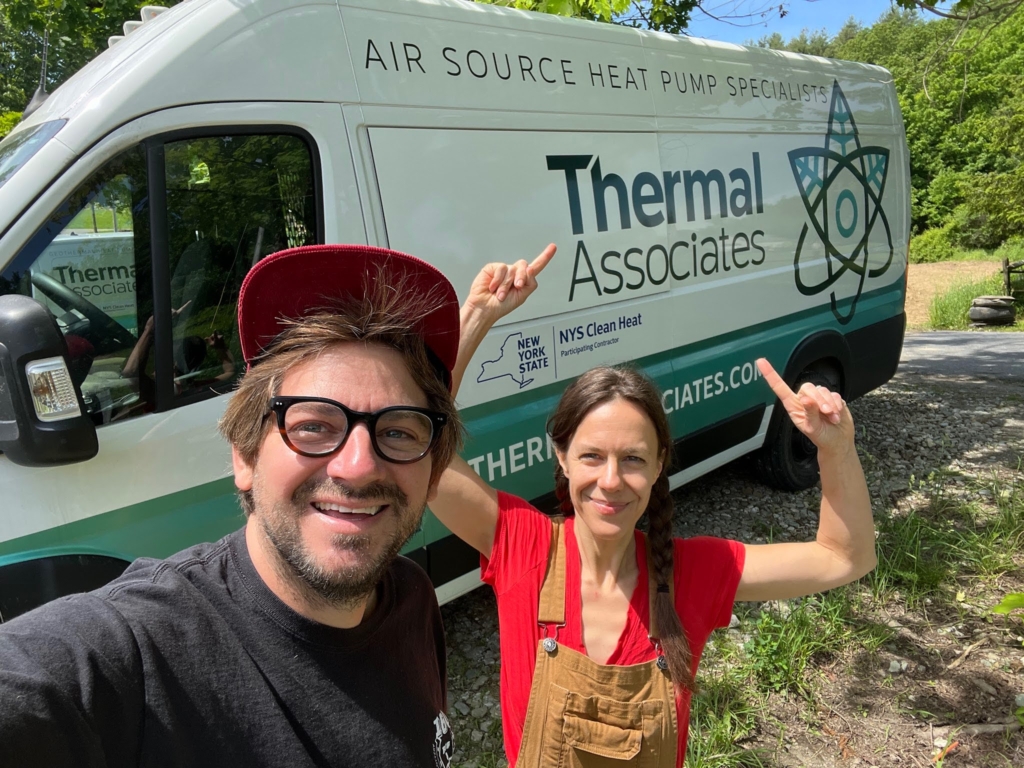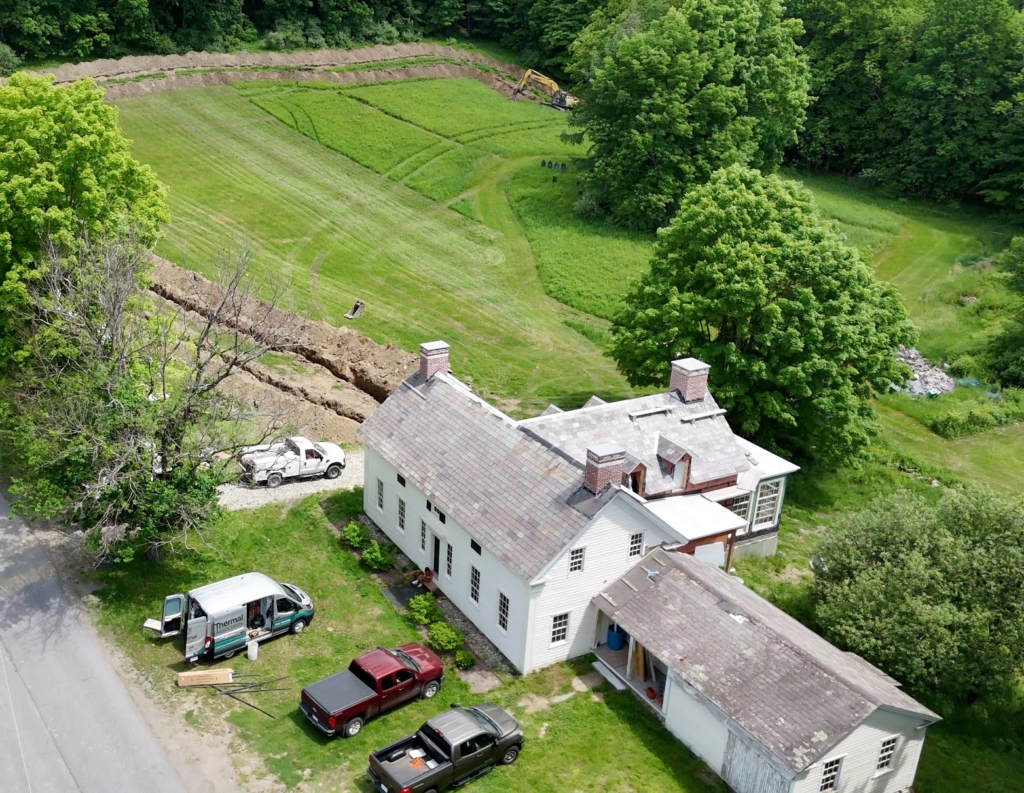There’s something undeniably magical about old houses. Their character, their charm, their whispering histories embedded in every creaky floorboard and ornate molding – these homes are living, breathing works of art. Yet, as any old house owner will tell you, they often come with a hefty energy bill and a few chilly drafts. Improving energy efficiency in your historic gem doesn’t mean stripping away its soul. By focusing on three critical upgrades – insulation and weatherization; equipment for heating, cooling, and water heating; and doors and windows – you can enhance your home’s comfort and sustainability while preserving its timeless appeal.
CIRCA founders, Ethan and Elizabeth Finkelstein, have partnered with NYS Clean Heat as they look to make energy-efficient choices for their own cheap old farmhouse renovation. We have included a few sneak peeks inside their journey as we show you how best to tackle energy-focused upgrades in any old home.

Insulation and Air Sealing, aka Weatherization
Weatherization, which includes both insulation and air sealing, isn’t the glamorous part of a restoration, but it plays a crucial part in reducing energy loss. Many old homes have little to no insulation, exacerbated by years of settling that reveals air leaks and gaps. More than half of a home’s energy use goes to space heating and cooling. Creating a tighter building envelope with insulation and air sealing keeps heated air in winter and cooled air in summer from leaking out and keeps unwanted moisture and outside temperatures from creeping in. Weatherization upgrades can generally reduce home energy use by 10-20% but those savings can be far higher in an older home starting with no insulation.
-Insulation Options for Old Homes-
Adding insulation improves energy efficiency by creating a barrier that reduces heat transfer through walls, ceilings, and floors to help maintain a stable indoor temperature year-round. When it comes to insulating your historic home, preservationists like Ethan and Elizabeth emphasize the importance of traditional cellulose or fiberglass insulation over spray foam options. Spray foam cannot be removed for future upgrades or renovations and permanently adheres to the surfaces it touches, which can sacrifice historical integrity. Both fiberglass and cellulose can be blown-in, which is a good option for getting inside existing attics and wall cavities and doesn’t require extensive modification to the home’s existing surfaces or structure. Another valuable feature of blown-in insulation is it can be “dense packed” inside certain building cavities like walls and some floor areas to provide insulation and air sealing at the same time. For a better understanding of different types of insulation and the best options for your home, work with a qualified weatherization contractor in your area.
-Weatherization: Sealing the Deal-
The most important place to air seal is in your attic. If not sealed properly, the heated air from your home will go straight out through your roof in the winter. Priority areas to seal include any openings where plumbing, wiring, chimneys or other elements pass through the ceiling into the attic. The tops of walls are another place where air leakage is common. Make sure to work with your contractor to select materials that are suitable for these locations and meet all fire safety codes. After addressing the attic, look to your basement – any by-passes or cracks around the rim joist (where the outside meets the inside).

Upgrading Heating & Cooling Systems and Water Heaters
Heating and cooling are at the heart of a home’s comfort, but modern technology now offers so many alternatives to the unsightly oil or propane tanks in backyards or basements. Water heaters are also a household necessity that can have a big impact on energy bills. Old houses often have outdated systems that are not only inefficient and compromise indoor air quality but can also be costly to run. Space heating and cooling can account for more than half of the energy use in a typical U.S. home, and water heating is typically the second-largest energy expense. Upgrading to a new, more efficient heat pump system will save you energy, which can lower your energy costs. Heat pumps provide heating and cooling using the same equipment so owners of older homes can get rid of their cumbersome and unsightly window AC units. Thankfully, modern heat pump technology offers a variety of solutions that can preserve the historic charm of walls, ceilings, and moldings, while improving the home systems within them.
Despite the name, heat pumps are dual systems that offer year-round heating and cooling running on electricity alone. Cold-climate heat pumps are available as ground-source (or geothermal) or air-source systems and have the lowest carbon emissions of any home heating equipment. They also eliminate air pollutants produced by combustion-based heating systems (such as oil, propane, natural gas, or wood-burning furnaces) like carbon monoxide, sulfur dioxide, or nitrogen oxides, which are unhealthy indoors and outdoors.
Beyond air quality and increased comfort, heat pumps require minimal maintenance and eliminate the hassle of scheduling fuel deliveries and worrying about fluctuating fuel costs. Plus, no installing and removing unaesthetic window AC units every spring and fall!
-Harnessing Earth’s Energy with Geothermal-
Geothermal ground-source heat pumps heat and cool your home by extracting energy from the earth’s consistent underground temperature. They are highly efficient, environmentally friendly, and can provide significant energy savings. A lot of times the components for a geothermal system are underground, so it doesn’t necessarily require outdoor condensers or large air ducts that could alter a home’s historical facade.
While installing the ground loops (the part of the geothermal system that is underground) does require some excavation, homeowners can work with their contractors to design a ground loop installation process that minimizes disruption and returns the landscape to an aesthetically pleasing condition. Ethan and Elizabeth selected a geothermal heat pump for their upstate NY cheap old farmhouse because of its outstanding temperature consistency, environmental benefits, and minimal intrusion on the interior of their home. Check out @FearNoFixer’s Instagram for a look inside Ethan and Elizabeth’s own install!
-Economic and Efficient Air-Source Heat Pumps-
Another fantastic option for old homes, air-source heat pumps work by transferring heat from the outside air rather than burning a fuel, making them much more efficient than traditional fossil fuel burning systems. If you have existing ducts in your home, it may be possible to use those ducts with a new heat pump system. In addition, ductless mini-split heat pumps are perfect for historic homes because they require minimal installation with many flexible design options, and they come in a variety of different styles and colors. This means you can preserve your home’s structure and aesthetics while enjoying modern comfort.
-Heat Pump Water Heaters-
Heat pump water heaters provide hot water up to three times more efficiently than conventional electric resistance water heaters. There are a few different types including those that can be connected to a geothermal system and those that use air-source heat pump technology to combine heating, cooling, and water heating, as well as stand-alone heat pump water heaters. Contact your local heat pump installer for more information on what water heater may be best for your home and how to maximize available benefits and rebates for your heating and cooling upgrades.

Preserving Historic Windows and Doors
What’s another leading culprit of energy loss that goes hand-in-hand with weatherization? Doors and windows. While the thought of replacing those original sash windows or that grand front door can feel like a betrayal to your home’s history, there are ways to retain these beloved features while improving energy efficiency and reducing energy costs for years to come.
-Maintaining Historical Accuracy-
Ethan and Elizabeth opted to renew their own farmhouse’s original windows to maintain the beloved wavy glass and historic charm. To get the most efficiency out of existing windows, consider caulking around the casings or frames surrounding the moving parts of the windows or installing window films. These methods can help reduce drafts and improve insulation without the need to replace the original windows, allowing you to keep those beautiful glass panes that have witnessed so much history. Strategic use of window treatments like shades and shutters can also help keep the cold at bay by closing them up at night and letting the warm sun in during the day during heating season.
-Insulating Storm Windows and Doors-
Adding storm windows and doors can provide an additional layer of insulation while maintaining the integrity of the original pieces. Modern insulating panels for windows are vastly improved from old-school storm windows and are designed to be unobtrusive and blend seamlessly with your home’s existing features. They act as a protective barrier against the elements, reducing heat loss in winter and heat gain in summer, all while letting the beauty of your original windows shine through.
If you do need to replace any or all windows, ENERGY STAR® certified windows rated for your climate region are the best choice for energy efficiency. Many manufacturers offer certified windows in a variety of materials and designs, including customized products to mirror original windows.
It’s critical to utilize reputable online resources and engage local experts to learn what energy-efficient upgrades may be best for your home. Many states, including New York, offer no or low-cost home energy assessments to identify where a home is wasting energy and suggest energy-saving improvements. For example, New Yorkers can connect with a contractor in their area through the Residential Energy Assessment Program.
Since 2023, Federal Inflation Reduction Act (IRA) tax credits have been available, and this year, some states (like New York) have begun rolling out rebates to provide upfront discounts on home energy upgrades. Many state energy offices, utilities, and product manufacturers, offer rebates, incentives, and low-interest financing for installing clean energy-efficient products like air sealing, insulation, heat pumps and water heaters, and windows and doors. These incentives can make it financially feasible to invest in energy-saving upgrades that maintain your home’s historic integrity.
Making your old house energy efficient doesn’t mean sacrificing its charm. With thoughtful upgrades, preserving history and embracing the future through modern efficiencies can go hand-in-hand.
About the Author

Susanne DesRoches is NYSERDA’s Vice President of Clean and Resilient Buildings leading the Authority’s work on building decarbonization, advancing programs and policies to deliver a carbon-neutral building stock. Prior to joining NYSERDA in April 2022, she served as Regulatory Director for Energy Policy at the New York City Mayor’s Office of Climate & Sustainability and Mayor’s Office of Climate Resiliency. While there, she was responsible for the City’s energy policy and regulatory affairs at the local, state, and federal levels, and directed the City’s policies and programs designed to adapt regional infrastructure systems to climate change, including electric, gas, and transportation systems and the City’s efforts to transition to 100 percent clean electricity by 2040. Ms. DesRoches led the City’s long-term energy planning efforts, which centered on decarbonization while prioritizing a just and affordable energy transition for all New Yorkers.
Ms. DesRoches also led the City’s efforts to ensure climate resiliency was integrated into utility and bulk power system planning and oversaw the development of the NYC Climate Resiliency Design Guidelines. She led the NYC Climate Change Adaptation Task Force, which works to identify climate risks and coordinate adaptation strategies and was a chapter author for the fourth National Climate Assessment.
Ms. DesRoches was previously the Chief of Resilience and Sustainability for the Engineering Department at the Port Authority of New York & New Jersey. She is highly regarded in the clean energy and resilience space, bringing expertise and rich experience in areas including climate policy, resiliency, city, and state partnerships level relationships, and building decarbonization. Ms. DesRoches holds a Bachelor of Industrial Design from Pratt Institute and an MPA in Environmental Science and Policy from Columbia University and is a LEED Accredited Professional. Susanne is on the faculty of Columbia University’s Earth Institute and School of Professional Studies.





